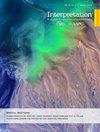基于监督机器学习和地质统计建模的岩相空间变异性研究:美国俄克拉何马州Sho-Vel-Tum油田Sycamore地层
IF 1
4区 地球科学
Q3 GEOCHEMISTRY & GEOPHYSICS
Interpretation-A Journal of Subsurface Characterization
Pub Date : 2023-01-10
DOI:10.1190/int-2022-0064.1
引用次数: 0
摘要
Sho Vel Tum油田的Sycamore组主要由富含粘土的泥岩和富含石英的粉砂岩组成。富含粘土的泥岩主要由粘土、石英颗粒、一些外来物和碎屑有机物组成。粉砂岩无结构,分为两个岩相:高孔渗块状钙质粉砂岩(MCSt)和低孔渗块状方解石胶结粉砂岩(MCcSt)。岩心和测井数据提供了矿物学、岩性和孔隙度信息,这些信息有助于定义岩石物理相(岩相)并在Sycamore地层内创建相测井。我们利用这些数据建立了Sycamore组的地层结构,并绘制了其空间变异性和储层性质图。为了对无芯井中的Sycamore组岩相进行分类,我们开发了一种基于机器学习的工作流程,该工作流程比较了1800多个分类模型,并选择测井曲线、算法和超参数的最佳组合来预测已定义的岩相。该过程包括在四种分类算法中优化的测井组合:人工神经网络(ANN)、K-最近邻(KNN)、支持向量机(SVM)和随机森林(RF)。为了调整每个分类器,我们使用网格搜索和5倍交叉验证来找到三个超参数的最佳组合,以改进每个算法的结果。该工作流程允许以低成本高效地从核心提取信息。在我们在无芯井中生成岩相测井后,我们将它们与多个约束条件相结合,创建了Sho Vel Tum油田Sycamore组的三维岩相模型,并分析了对岩相的地层和成岩控制及其对储层质量的影响。本文章由计算机程序翻译,如有差异,请以英文原文为准。
Spatial variability of petrofacies using supervised machine learning and geostatistical modeling: Sycamore Formation, Sho-Vel-Tum Field, Oklahoma, USA
The Sycamore Formation at Sho-Vel-Tum Field primarily consists of clay-rich mudstones and quartz-rich siltstones. The clay-rich mudstones are mainly composed of clays, quartz grains, some allochems and detrital organic matter. The siltstones are structureless and are divided into two petrofacies: high porosity and permeability massive calcareous siltstones (MCSt) and low porosity and permeability massive calcite-cemented siltstones (MCcSt). Core and well-log data provide mineralogical, lithological, and porosity information that is useful to define petrophysical facies (petrofacies) and to create facies logs within the Sycamore Formation. We used the data to establish the Sycamore Formation stratigraphic architecture and to map its spatial variability and reservoir properties. To classify the Sycamore Formation petrofacies in non-cored wells we developed a machine learning-based workflow that compares over 1,800 classification models and selects the best combination of well logs, algorithms, and hyperparameters to predict defined petrofacies. The process includes combinations of well logs that were optimized in four classification algorithms: Artificial Neural Network (ANN), K-Nearest Neighbor (KNN), Support Vector Machine (SVM), and Random Forest (RF). To adjust each classifier, we used a Grid-Search and a 5-fold cross-validation to find the best combination of three hyperparameters to improve results of each algorithm. This workflow allows for the efficient extraction of information from cores at a low cost. After we generated petrofacies logs in non-cored wells, we combined them with multiple constraints to create a 3D petrofacies model for the Sycamore Formation at Sho-Vel-Tum Field and analyze the stratigraphic and diagenetic controls on petrofacies and its impact in reservoir quality.
求助全文
通过发布文献求助,成功后即可免费获取论文全文。
去求助
来源期刊

Interpretation-A Journal of Subsurface Characterization
GEOCHEMISTRY & GEOPHYSICS-
CiteScore
2.50
自引率
8.30%
发文量
126
期刊介绍:
***Jointly published by the American Association of Petroleum Geologists (AAPG) and the Society of Exploration Geophysicists (SEG)***
Interpretation is a new, peer-reviewed journal for advancing the practice of subsurface interpretation.
 求助内容:
求助内容: 应助结果提醒方式:
应助结果提醒方式:


